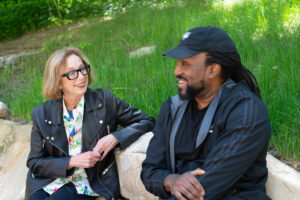Sundance Institute
Sundance.org is dispatching its writers to daily screenings and events to capture the 10 days of festivities during the Sundance Film Festival in Park City, Utah. Check back each morning for roundups from the previous day’s events.
Blue Caprice
By Eric Hynes
“I’ve created a monster,” John Allen Muhammad (Isaiah Washington) says to his surrogate son Lee Boyd Malvo (Tequan Richmond) in this tense true crime thriller, and he doesn’t mean it figuratively. Based on the events surrounding the Beltway sniper rampage, in which Muhammed and Malvo killed at least ten strangers, mostly in public spaces, in the Maryland/Northern Virginia/Washington, D.C. area in 2002, Blue Caprice is an insightful psychological portrait of two men whose bitterness and mutual need descended into cold-blooded collaborative murder.
In the post-screening Q&A, debut filmmaker Alexandre Moors described how the idea for a thriller came first, followed by his discovery of the Beltway sniper story. “The conciseness of the premise—the father and son, the primal, the tragic,” is what made him interested in pursuing film, he said. “And it was a good vehicle for talking about violence in this country.”
Moors collaborated on the script with R.F.I. Porto, who spoke about toeing the line between fact and fiction. “We knew that we were going to make something speculative without firsthand access to our main characters. We were using second hand evidence to piece together the story, so there’s going to be a gulf between your story and what happened,” Porto said. “But we didn’t invent facts—all of our scenes are connected to a transcript or actual anecdote.”
The film does an impressive job of interrogating violence without indulging in it. Though several of the homicides needed to be depicted, the filmmakers sought to do so with restraint. “You’re faced with a bunch of moral choices about what you’re going to show or leave out,” Moors said. “I had little interest in showing people get killed. So we focused on the teaching of the violence, how it becomes accessible.”
Some of the most upsetting scenes of the film involve Muhammed teaching Malvo how to fire a gun, and few things are as chilling as the thunderous clap of the weapon being fired. “We spent a lot of time taking care of that,” Moors said of the sound effect. “I went shooting before making this film and found it incredibly disturbing—the energy it put into my body. And also it was really loud.”
Porto addressed the question of whether a film like Blue Caprice could in turn inspire more violence. “We don’t need a film in order to have copycat,” he said, mentioning another round of gun-related homicides that took place a few days prior in Albuquerque, New Mexico. “The cycle of violence is steady enough as it is.”
Toy’s House
By Jeremy Kinser
Director Jordan Vogt-Roberts returns to Park City with a rare bird—an often-uproarious coming-of-age comedy without a lick of sentimentality. Toy’s House, screening at Sundance in the Dramatic Competition, follows three discontented teenage boys (Nick Robinson, Gabriel Basso, and Moises Arias) as they head into the wilderness to begin a new life living off the land.
During the Q&A, Vogt-Roberts, whose short Successful Alcoholics screened at the 2010 Sundance Film Festival, noted he enjoys working with comedic actors. “The comedy world is small so I just asked my friends,” he said. Apparently that friends list includes Megan Mullally and her husband Nick Offerman. The director returned their generosity by giving both actors memorable characters to play. Offerman, whose aplomb with a one-liner is undeniable, reveals unexpected depth here as the widowed father of the protagonist.
Asked about the three young leads, Vogt-Roberts said it was important to cast real teenagers, who still feel awkward. “We didn’t want glossy Hollywood actors playing 15,” he revealed. “We wanted pimples on their faces. As soon as Nick and Gabriel and Moises came in we just knew.”
Although the tale isn’t strictly autobiographical, screenwriter Chris Galletta based the story somewhat on friends he had while growing up. “One of our friends had divorced parents so he had the run of his house all summer long,” he told the audience. “I thought it would be funny to make that into a literal idea of kids running a household.”
The filmmaker acknowledged that while Galletta’s screenplay was always used as a base, some scenes were largely improvised and he sent the three teenaged actors to improv class. “Not so they’d be super quick or witty or a joke a minute,” he said. “But if I didn’t yell cut or if we changed the scene on the fly, they’d be comfortable.” Vogt-Roberts added that since neither he nor Galletta are teenagers, he also wanted to know what the young actors would bring to the situations.
Set in the remote woods of Ohio, the boys encounter wildlife, including an alarming encounter with a copperhead snake. Vogt-Roberts addressed the challenges of working with an untrainable animal. “The snake was a real dick,” he said. “He did not cooperate and there are a bunch of weird photos of me trying to move the snake around.”
Vogt-Roberts acknowledged another of the film’s more striking elements— the cinematography, which hearkens back to ‘80s favorites such as The Goonies, rather than the flat sitcom look of many contemporary comedies. “We think that comedy can be beautiful and have texture and have style,” he offered. “We tried to bring that back.”
Escape from Tomorrow
By Eric Hynes
“This is a special film for very special people,” is how Senior Programmer Shari Frilot introduced Escape From Tomorrow on Thursday night, and she wasn’t really kidding. This low-rent little film from a previously unknown filmmaking team has become one of the most notorious films of this year’s Festival—as well as one of its hottest tickets, as numerous people milled about the parking lot at the Library Theater hoping to scalp their way into the sold out screening. The major point of discussion has been whether or not the film can ever been seen outside of Park City, being that a large portion of it was shot on the sly on the notoriously legally-restricted grounds of Disneyland and Disneyworld. Yet as of last night, director Randy Moore said he hadn’t heard from the entertainment conglomerate, leaving the legend of Escape From Tomorrow to continue apace.
The film recounts a day in the life of Jim (Roy Abramsohn), a recently fired father of two who slowly descends in a hellish, surrealistic nightmare—complete with witches, evil scientists, feline diseases and seductive French teens—as he traverses the happy environs of the family theme park. “I spent a lot of time in Orlando as a child,” Moore said. “Then I returned as a parent and saw it in a new light.” Though it might seem like the film was reliant on improvisations and advantageous accidents, Moore said that every shot was mapped out. Yet actually executing those shots proved to be a challenge. “We showed up every night for 10 days in order to get the fireworks, to capture it from all of the angles,” he said, and described the tedium of repeating the same rides ad nauseum. And as for whether or not the filmmakers ever sought permission to make the movie? “We bought season tickets to the park,” said Moore with a smile.
The Gatekeepers
By Jeremy Kinser
As the debate rages on about the factual sourcing behind Zero Dark Thirty, director Dror Moreh redefines the phrase insider access with The Gatekeepers, his riveting examination of the Israeli-Palestinian conflict in the aftermath of 1967’s Six-Day War. The Israeli filmmaker achieves an astonishing feat in having convinced all six former heads of the Shin Bet, Israel’s historically secretive internal security agency, to grant one-on-one interviews and speak candidly on camera about their participation in the policies that have shaped the long, turbulent history of violence between Israelis and Palestinians.
In addition to his use of fascinating and often incredibly violent archival footage, Moreh convinced the half-dozen men to weigh in on topics that range from preemptive strikes to confronting both Palestinian and Israeli terrorists. Each man is pragmatic and speaks calmly about bombs being dropped on private homes and terrorists being beaten to death. While they regret bombings that caused the deaths of innocent people, they also regret ones that did not result in more deaths of the guilty.
The 2012 film, which has been named best nonfiction film by the National Society of Film Critics and nominated for an Academy Award in the best documentary feature category, is being shown at Sundance as a Spotlight presentation.




